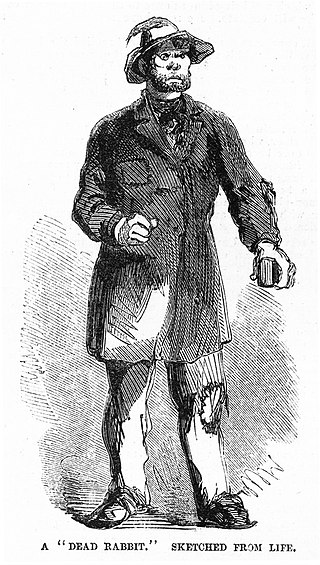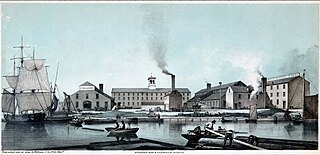Related Research Articles

Five Points was a 19th-century neighborhood in Lower Manhattan, New York City. The neighborhood, partly built on low lying land that had filled in the freshwater lake known as the Collect Pond, was generally defined as being bound by Centre Street to the west, the Bowery to the east, Canal Street to the north, and Park Row to the south. The Five Points gained international notoriety as a densely populated, disease-ridden, crime-infested slum that existed for over 70 years.

The Dead Rabbits was the name of an Irish American criminal street gang active in Lower Manhattan in the 1830s to 1850s. The Dead Rabbits were so named after a dead rabbit was thrown into the center of the room during a gang meeting, prompting some members to treat this as an omen, withdraw, and form an independent gang. Their battle symbol was a dead rabbit on a pike. They often clashed with Nativist political groups who viewed Irish Catholics as a threatening and criminal subculture. The Dead Rabbits were given the nicknames of "Mulberry Boys" and the "Mulberry Street Boys" by the New York City Police Department because they were known to have operated along Mulberry Street in the Five Points.

William Poole, also known as Bill the Butcher, was the leader of the Washington Street Gang, which later became known as the Bowery Boys gang. He was a local leader of the Know Nothing political movement in mid-19th-century New York City.

The Plug Uglies were an American Nativist criminal street gang, sometimes referred to loosely as a political club, that operated in the west side of Baltimore, Maryland, from 1854 to 1865. The term plug ugly was used to identify an extremely tough ferocious fighter who could give a sound beating to an opponent, with the Plug Uglies' name additionally stemming from their practice of stuffing oversized plug hats with wool and leather, pulling them down over their ears for head protection as primitive helmets during the numerous street battles they participated in. The name Plug Uglies was used to refer to a number of criminal gangs in New York City as well as Philadelphia.

The Roach Guards were an Irish criminal gang in Five Points neighborhood of New York City the early 19th century. The gang was originally formed to protect New York liquor merchants in Five Points and soon began committing robbery and murder. The Roach Guards took their name from their founder and leader Ted Roach.

The Bowery Boys were a nativist, anti-Catholic, and anti-Irish criminal gang based in the Bowery neighborhood of Manhattan, New York City in the early-mid-19th century. In contrast with the Irish immigrant tenement of the Five Points, the Bowery was a more prosperous working-class community. Despite its reputation as one of the most notorious street gangs of New York City at the time, the majority of the Bowery Boys led law-abiding lives for the most part. The gang was made up exclusively of volunteer firemen—though some also worked as tradesmen, mechanics, and butchers —and would fight rival fire companies over who would extinguish a fire. The Bowery Boys often battled multiple outfits of the infamous Five Points, most notably the Dead Rabbits, with whom they feuded for decades. The uniform of a Bowery Boy generally consisted of a stovepipe hat in variable condition, a red shirt, and dark trousers tucked into boots—this style paying homage to their fireman roots.

The Gangs of New York: An Informal History of the Underworld is an American non-fiction book by Herbert Asbury, first published in 1928 by Alfred A. Knopf. It was the basis for Martin Scorsese's 2002 film Gangs of New York.
The Baxter Street Dudes was a New York City teenage street gang, consisting of former newsboys and bootblacks, who ran the Grand Duke's Theatre from the basement of a dive bar on Baxter Street in Manhattan during the 1870s. Led by founder Baby-Face Willie, gang members operated the Grand Duke's Theatre and established the venue as their headquarters. Members of the Baxter Street Dudes wrote and performed plays, musicals and variety shows which were enjoyed by other street toughs and slummers throughout the city. The theater house eventually became a popular underworld hangout, from which the gang found financial success.
Lewis "Lew" Baker was a Welsh-American patrolman in the New York Police Department who was simultaneously employed as a "slugger" for Tammany Hall. He was involved in voter intimidation and election fraud during the 1840s and 1850s. A close friend and associate of Irish mob boss John Morrissey, Baker frequently battled supporters of the nativist Know-Nothing movement for over a decade. He is most remembered however as the assassin of William "Bill the Butcher" Poole. Baker shot and killed Poole in a Broadway saloon during a brawl. Both Baker and Morrissey were placed on trial for murder, but were acquitted.
Hell-Cat Maggie was the pseudonym of an American outlaw and early member of the Dead Rabbits. She was a well-known personality in Manhattan's Five Points district and a noted fighter, her teeth reportedly filed into points and her fingers adorned with long, claw-like brass fingernails. She fought alongside the Dead Rabbits and other Five Pointers against rival nativist gangs from the Bowery, most especially the Bowery Boys, during the early 1840s. Although there is little information about her life, she is one of the earliest female outlaws of the "Gangs of New York" era and has been compared to other female outlaws such as Gallus Mag and Battle Annie, the latter leading the female auxiliary of the Gopher Gang during the 1870s.

James "Wild Jimmy" Haggerty was an American criminal and well-known underworld mob figure in Philadelphia and later in New York City during the mid-to late 19th century. Jimmy Haggerty was the leader of the Schuylkill Rangers, a predominantly Irish-American street gang, which terrorized the South Philadelphia waterfront, specifically its local wharves and coal yards, for over 25 years.
James Turner was an American criminal figure, pugilist and "slugger" for Tammany Hall. Turner was one of several men under Captain Isaac Rynders who committed voter intimidation and election fraud for Tammany Hall during the 1850s. He and Paudeen McLaughlin were bodyguards to Lew Baker and were present with him when Baker fatally shot William "Bill the Butcher" Poole in the back in 1855.

The Dead Rabbits riot was a two-day civil disturbance in New York City evolving from what was originally a small-scale street fight between members of the Dead Rabbits and the Bowery Boys into a citywide gang war, which occurred July 4–5, 1857. Taking advantage of the disorganized state of the city's police force—brought about by the conflict between the Municipal and Metropolitan police—the fighting spiraled into widespread looting and damage of property by gangsters and other criminals from all parts of the city. It is estimated that between 800 and 1,000 gang members took part in the riots, along with several hundred others who used the disturbance to loot the Bowery area. It was the largest disturbance since the Astor Place Riot in 1849 and the biggest scene of gang violence until the New York Draft Riots of 1863. Order was restored by the New York State Militia, supported by detachments of city police, under Major-General Charles W. Sandford.
Syksey was the pseudonym of an American criminal and member of the Bowery Boys. He was supposedly the lieutenant and longtime companion to Mose the Fireboy during the 1840s, often the storyteller of his feats, and is credited for coining the phrase "hold 'de but", a common expression used during the mid-to late 19th century meaning to borrow a dead cigar or to "bum a smoke". He was later portrayed in Benjamin Baker's play Mose, the Bowery B'hoy which performed at the old Olympic Theater in 1849 and later toured throughout the United States during the late 1840s and 50s. His pseudonym may have been derived from Bill Sikes, the sidekick of gang leader Fagin from Oliver Twist.
Captain Isaiah Rynders was an American businessman, sportsman, underworld figure and political organizer for Tammany Hall. Founder of the Empire Club, a powerful political organization in New York during the mid-19th century, his "sluggers" committed voter intimidation and election fraud on behalf of Tammany Hall throughout the 1840s and 1850s before Tammany became an exclusively Irish-dominated institution.
Ah Ken, also known as Ah Kam, was a well-known Chinese American businessman in Chinatown, Manhattan (曼哈頓華埠) during the mid-to late 19th century. The first Asian man to permanently immigrate to Chinatown, although Quimbo Appo is claimed to have arrived in the area during the 1840s, Ah Ken resided on Mott Street and eventually founded a successful cigar store on Park Row.

Gang colors include clothing, accessories, or tattoos of a specific color or colors that represent an affiliation to a specific gang or gang branch.
Christopher Keyburn, commonly known by his alias Kit Burns, was an American sportsman, saloon keeper and underworld figure in New York City during the mid-to late 19th century, he and Tommy Hadden being the last-known leaders of the Dead Rabbits during the 1850s and 60s.

William McGlory was an American saloon keeper and underworld figure in New York City during the mid-to late 19th century. He was well known in The Bowery and Five Points districts, owning a number of popular establishments throughout the city, most notably McGlory's Armory Hall, a popular Bowery hangout for members of the underworld in the old Fourth and Sixth Wards.
References
- 1 2 3 Asbury, Herbert. The Gangs of New York: An Informal History of the New York Underworld. New York: Alfred A. Knopf, 1928. (pg. 26-27, 102, 106) ISBN 1-56025-275-8
- 1 2 Peterson, Virgil W. The Mob: 200 Years of Organized Crime in New York. Ottawa, Illinois: Green Hill Publishers, 1983. (pg. 13) ISBN 0-89803-123-0
- 1 2 Kenney, Dennis Jay and James O. Finckenauer. Organized Crime in America. New York: Wadsworth Publishing Company, 1995. (pg. 75) ISBN 0-534-24702-4
- ↑ Sobol, Louis (November 18, 1965). "New York Cavalcade: Paid Killers and the Underworld". Daytona Beach Morning Journal . Retrieved October 31, 2012.
- 1 2 Giamo, Benedict. On the Bowery: Confronting Homelessness in American Society. Iowa City: University of Iowa Press, 1989. (pg. 9) ISBN 0-87745-243-1
- 1 2 Sante, Lucy. Low Life: Lures and Snares of Old New York. New York: Farrar, Straus & Giroux, 2003. (pg. 200-203) ISBN 0-374-52899-3
- ↑ Kett, Joseph F. Rites of Passage: Adolescence in America, 1790 to the Present. New York: Basic Books, 1977. (pg. 92) ISBN 0465070434
- 1 2 "Murderous Gangs Of A Half Century And More Ago" (PDF). The New York Times . August 4, 1912. Retrieved October 31, 2012.
- ↑ Beals, Carleton. Brass-Knuckle Crusade: The Great Know-Nothing Conspiracy, 1820-1860. New York: Hastings House, 1960. (pg. 20)
- ↑ "The Gangs of New York: Facts That Out Thrill Fiction". The Milwaukee Sentinel . November 13, 1928. Retrieved October 31, 2012.
- ↑ Ferrara, Eric. The Bowery: A History of Grit, Graft and Grandeur. Charleston, South Carolina: The History Press, 2011. (pg. 50) ISBN 1-60949-178-5
- ↑ Mendelsohn, Joyce. The Lower East Side Remembered and Revisited: A History and Guide to a Legendary New York Neighborhood. New York: Columbia University Press, 2009. (pg. 238) ISBN 0-231-14761-9